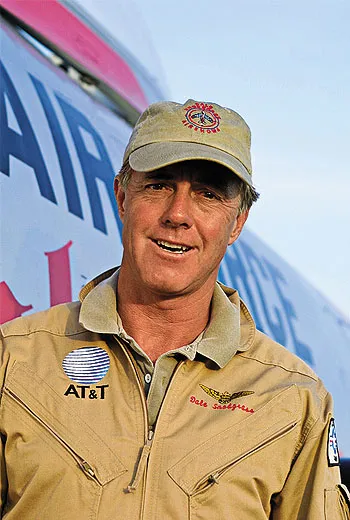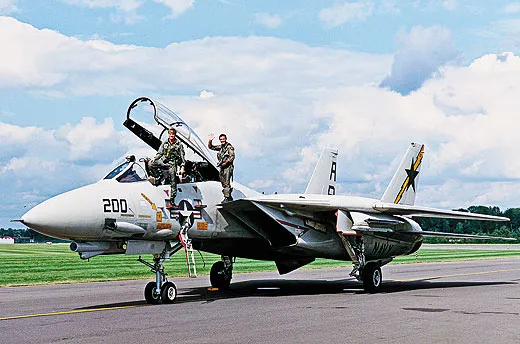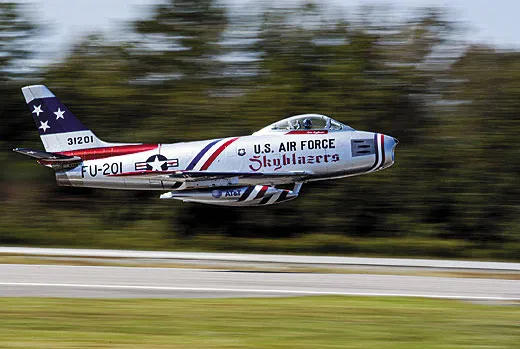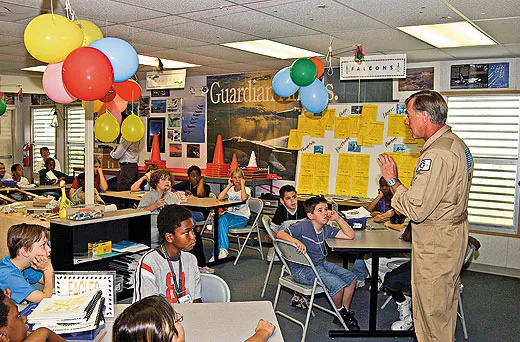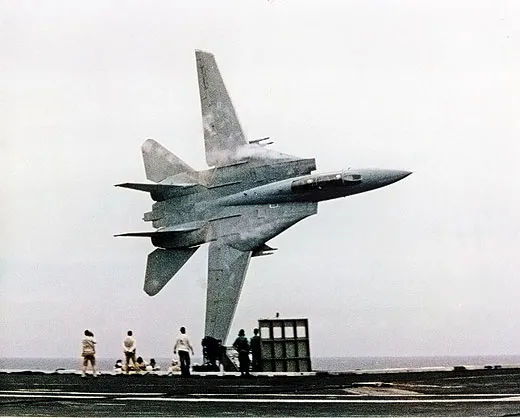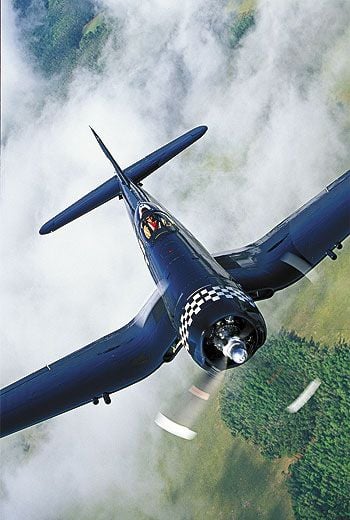The Real Top Gun
Nobody handled a Tomcat like Snort
/https://tf-cmsv2-smithsonianmag-media.s3.amazonaws.com/filer/Top_Gun_FLASH.jpg)
As the F-14 tomcat rounded the fantail on the aircraft carrier’s port side, Dale Snodgrass whipped it into an 85-degree banked turn. With its right wingtip below the flight deck, the jet sliced past the spectators, rolled wings level and pulled up into the vertical S of a double Immelman, then shot back down into a high-G aerobatic performance that flung mist off the wings like fur in a catfight.
It was the 1988 Dependents’ Day Cruise for the families of the USS America personnel, and as he did with all demos at sea, he made that first pass and his impossibly tight turns right alongside the boat, a spitball’s distance from the flight deck.
A third class petty officer caught the first pass in a snapshot. When Snodgrass saw the photo, he said, “Holy cow! Make me 50 copies and burn the negative. I don’t want that to follow me.” But it has, becoming one of the most passed-along photographs in airshow history. And it is classic Snodgrass: low and close, in the right place at the right time with the talent for making an airplane pop out of the sky and into the mind’s eye.
During his naval aviation career, Snodgrass, whose call sign is Snort, became the definitive F-14 pilot. He got into the airplane straight out of flight school in 1974, when the F-14 was new and no other low-time pilots had flown it. He was the first in that category to land it on a carrier, both day and night. In 1978 he attended Top Gun, the Navy Fighter Weapons School, which turns the best pilots into instructors. In 1985, he became the Navy’s Fighter Pilot of the Year. The following year, the film Top Gun turned the viewing public into crazed F-14 fans (Snodgrass did a little flying for it), and Grumman named him Topcat—Best F-14 Pilot of the Year. He trained so many young fighter pilots and staged so many dogfights in it that he became unbeatable. He also flew more displays over more years than any other military demo pilot. Flying the F-14 in war and in peace, he has racked up more than 4,800 hours, making him the highest-time Tomcat pilot in history.
Snodgrass loves flying airshows, and even when he became Commander Fighter Wing Atlantic, commanding all the F-14s in the Navy, he continued to find a way to fly. “I started doing the demos and I liked it so much that I stayed connected to the airshow circuit by hook and by crook from 1985 to 1997—12 years, which was unprecedented in military demo flying,” he says. “Everybody did two, three years.” He made 400 demonstration flights in the Navy.
In 1985 he met a group of pilots from the Kalamazoo Aviation History Museum in Michigan. The museum had acquired one of each of the piston warbirds that Grumman manufactured and named for cats—the Wildcat, the Hellcat, the Bearcat, and the twin-engine F-7F Tigercat—and flew them in an airshow act called Flight of the Grumman Cats. Snodgrass and the pilots agreed to fly together. The Navy provided the Tomcat, and Snodgrass flew with the Kalamazoo team in their second performance. It was a powerful moment for the crowd: the first time they had seen old warbirds flying in close formation with a modern jet.
The chemistry between the warbird pilots and Snodgrass was magical. His father had been a World War II marine aviator flying F4U Corsairs in the Pacific and had become a Grumman engineering test pilot, so Snort had a special affinity for the old fighters. The Kalamazoo pilots were impressed and surprised by his flying.
Retired Navy F-4 Phantom pilot John Ellis, who led the formation, says, “The slow speeds we flew were pretty challenging for an F-14 pilot when we were maneuvering, and we expected him to fly with his wings extended forward in landing configuration…but he joined up and immediately swept his wings back.”
Flying with the wings back reduced the amount of lift they generated, and the speeds the group flew put the F-14 close to stalling at times. But Snodgrass flew with skill and finesse, and the higher power settings required in the delta-wing configuration gave him more throttle control, a critical factor in smooth formation flying.
Over the next 11 years Snodgrass became close friends with the Kalamazoo pilots, sought advice from top civilian show pilots, flew shows with the Grumman cats whenever possible, and learned to fly piston warbirds himself. All of this led to several extraordinary things, the most memorable of which is the 1996 Flight of the Twin Engine Cats.
After Desert Storm,where Snodgrass served as a squadron commander and led 34 strikes, he and Ellis designed a sequence that included the F-14 and the Tigercat flying formation aerobatics. He then spent about 10 days practicing at the Air National Guard base in Battle Creek, Michigan, to see if and how it could be done.
Flying close magnifies the risk of collision, especially between dissimilar airplanes, so flying formation requires a great deal of trust between the pilots. The Tigercat, a sleek 1940s design, and the F-14 are so different that most pilots could not imagine the two flying formation aerobatics. During the nose and wing attitude changes of a looping or rolling maneuver, the speed and flying characteristics of each airplane change in dramatically different ways. One airplane can accelerate while the other slows up. One airplane might need massive amounts of power, while the other’s throttle is nearly at idle.
Snodgrass had been thinking about it for a long time and felt sure he could do it. Ellis decided he was willing to try: “There are some pilots who seem to have a special sense of awareness of where they are at all times,” he says. “Dale has that particular ability. His flying is smooth and aggressive at the same time. His senses are a little sharper than other people’s. He knows when he is an inch from the ground, when he has wingtip clearance and can roll the plane into knife edge right on takeoff.”
Air boss Ralph Royce describes the first time he saw them. “On the runway, you could hear the 2800s [Pratt & Whitney engines] on the Tigercat and could barely hear the jet. They came down the runway, the Tigercat humming and Snort not even in [after]burner. Ellis lifted off and kept it fast. Snort stayed under him. Then he came off the runway, sucked the gear up, and called ‘Pull.’ I’ve seen a lot of guys do a lot of things in airplanes and I don’t get impressed too easily, but when I saw that I said, ‘Ho boy, we’ve got something different here’…. They were clearly two consummate professionals working at the peak of their ability.”
All of Snodgrass’ display flying has been amazing: from the crisp, aggressive demos of the F-14 to the elegant solos in P-40s, P-51s, T-6s, and boomerang-winged F-86s. His new formation act makes the retro beauty of the MS-760 Paris Jets sexy again. But nothing compares to the Flight of the Twin Engine Cats. It also gave birth to the Navy’s Legacy Flights and the Air Force’s Heritage program, both of which pair old and new fighters at airshows.
In spite of his remarkable flying skills, and his ability to manipulate the rules to do extraordinary things, Snodgrass, like all junior officers flying red-hot machines, occasionally found himself in trouble for hotshot flying. Once, for example, a high-speed flyby with an aerobatic split-S to a landing got him confined to quarters for 10 days.
But nothing impeded his progress up through the Navy or out into the civilian airshow world, in which he has enjoyed a fully sponsored career since 1999. He has also taught advanced bush flying to pilots in Africa. And in St. Augustine, Florida, where he lives with his wife, Denise, he teaches formation flying and aerobatics to warbird owners, and provides upset training—recovering from unintentional aerobatic flight—for corporate pilots and MS-760 Paris Jet customers.
Meanwhile, more than two decades later, the famous photograph has taken on a life of its own, showing up all over cyberspace. When I showed it to the man behind the Starbucks counter pouring espresso shots into my latte, he already knew it. “Oh yeah,” he said. “That’s the Top Gun guy.”
